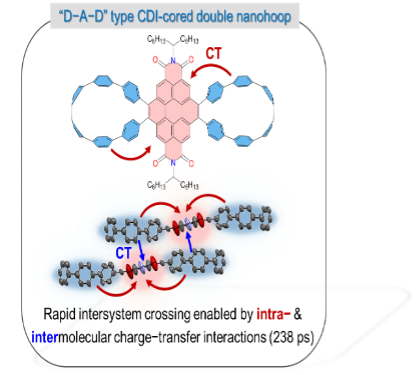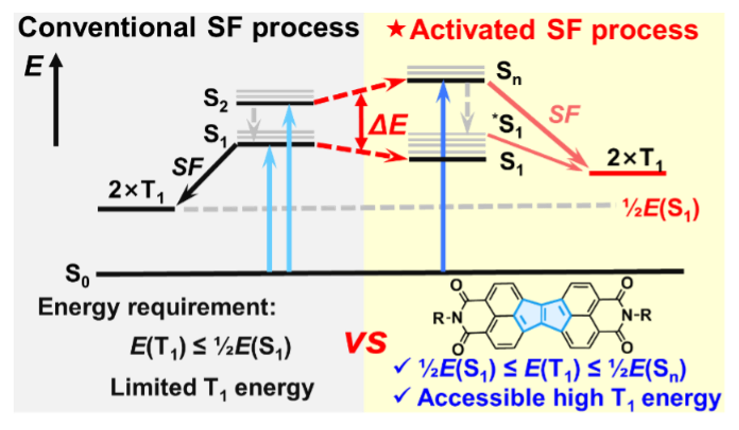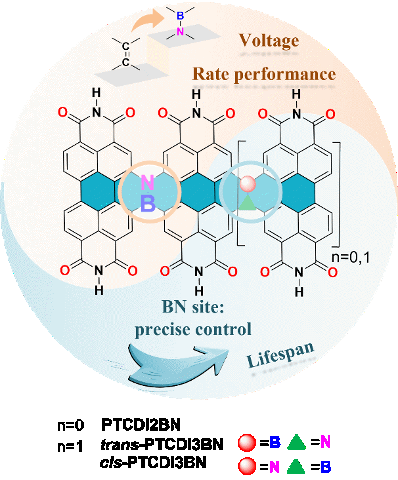
Recently, Associate Professor Wu Di from School of Chemistry, Chemical Engineering and Life Science has made significant research progress in the field of organic optoelectronic materials. The relevant findings have been successively published in top international chemistry journals such as Angewandte Chemie - International Edition, Journal of the American Chemical Society, and Chemical Science.
The research team led by Wu Di and Xia Jianlong has long been focusing on the design, synthesis, and performance study of acyl imine materials. They have elucidated the structure-property relationship of molecular structures and exciton dynamics, proposed a novel strategy of donor-acceptor-donor molecular construction, utilized the self-assembly behavior of "pseudo-eutectic" in membrane phase to regulate the intermolecular charge transfer effect, and achieved the rapid intersystem crossing (238ps) in bicyclic molecules (CDI-CPP, see Figure 1). This provides theoretical guidance and new material design ideas for the precise control of exciton dynamics in intersystem crossing materials. The achievement, titled "Appending coronene diimide with carbon nanohoops allows for rapid intersystem crossing in neat film," has been published in Angewandte Chemie-International Edition, with doctoral student Zhao Jingjing and graduate student Xu Jingwen as co-first authors of the paper.

Figure 1 Design Strategies and Stacking Structures of Bishelix Molecules
The research team has proposed a new design strategy for acyl imide singlet fission materials, developing a novel system of pentacyclic enamine acyl imide materials, which elevates the triplet energy level of singlet fission materials to 1.0 eV (Fig 2), providing a new design approach for the development of singlet fission materials with high triplet energy levels. The result, titled "Activated singlet fission dictated by anti-Kasha property in a rylene imide dye," was published in the Journal of the American Chemical Society, with doctoral students Wang Kangwei and You Xiaoxiao as co-first authors of the paper.

Figure 2 The Schematic Diagrams of Traditional Single-strand Cleavage and Activated Single-strand Cleavage
The team has also developed boron-nitrogen co-doped aromatic imide materials (Figure 3), which exhibit high working potential in organic secondary batteries, demonstrating excellent rate performance (rechargeable to 69% of maximum capacity in 19 s) and cycling stability (30,000 cycles). The related research findings have been published in Chemical Science (DOI: 10.1039/d3sc06331c).

Figure 3 Design strategy of BN-embedded PDI oligomers for high-performance organic electrode potassium-ion batteries
Wu Di, Associate Professor and Master's Supervisor of the School of Chemistry, Chemical Engineering and Life Sciences. He specializes in the development and application of novel organic semiconductor materials. He has published over 60 papers in journals such as Chem, Chem. Soc. Rev., Acc. Chem. Res., J. Am. Chem. Soc., and Angew. Chem. Int. Ed., with more than 3000 citations. Three of his papers have been listed as highly cited papers by ESI, and he has applied for over ten invention patents.
Paper Links:
1. https://onlinelibrary.wiley.com/doi/10.1002/anie.202400941(Angew. Chem. Int. Ed.)
2. https://pubs.acs.org/doi/10.1021/jacs.4c01732(J. Am. Chem. Soc.)
3. https://pubs.rsc.org/en/content/articlelanding/2024/sc/d3sc06331c(Chem. Sci.)
Written by: Wu Di
Rewritten by: Wang Jingjing
Edited by: Yu Mengmei, Li Tiantian
Source: School of Chemistry, Chemical Engineering and Life Science
|
|